Displaying items by tag: Lakota
It May Be A New Round Ireland Record But The Three Hour Margin Tells Us What A Great Job Lakota Did 22 Years Ago
#roundirelandrecord – At his fourth attempt, top French skipper Sidney Gavignet with the Mod 70 trimaran Musandam-Oman Sail has finally toppled the long-standing Round Ireland record set in September 1993 by American Steve Fossett with the 60ft trimaran Lakota, but by only three hours.
And if anything, the Gavignet achievement has heightened just what a remarkable job was done 22 years ago when the American skipper with his smaller, heavier and much less technically advanced boat set such an exceptional time writes W M Nixon.
Unlike the state-sponsored Musandam-Oman campaign (and it's one very rich state), the Lakota project was very much a private enterprise effort, with Fossett's crew including husband-and-wife multi-hull enthusiasts Con Murphy and Cathy MacAleavey of the National YC in Dun Laoghaire. They had met the Lakota crew in Portugal some months earlier, and had persuaded them that a successful round Ireland challenge was just what was needed to set Fossett's sailing on the track to high achievement, and their suggestion succeeded brilliantly on both counts.
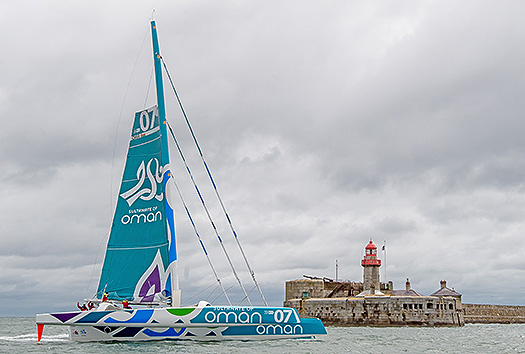
The new record holders – The mighty Mod70 returns to Dun Laoghaire this morning
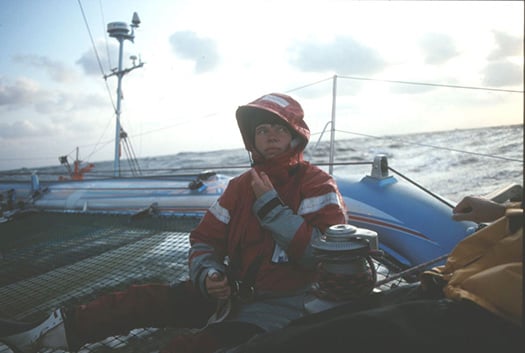
Cathy MacAleavey in some of the gentler conditions during Lakota's successful challenge

Getting there – when Lakota went past the Fastnet during her 1993 anti-clockwise circuit, they knew they were well on their way with the chance of an outstanding record.
Lakota's startling new time of 44 hours was not easily achieved, as the boat had arrived in Dun Laoghaire with a damaged mainsail which had to be rushed to Crosshaven for repairs by McWilliam Sailmakers while the clock was remorselessly ticking down towards the ideal situation of a vigorous low pressure area becoming centred over Ireland.
But as it happened, the Gods were on their side. The delay while waiting for the sail repair made the weather situation even better as far as records were concerned, and Lakota went round in style as regards speed, though for quite a lot of the passage she was sailing in conditions in which most people would have been very content to stay comfortably at home in front of a large fire.
And as the Lakota challenge included Irish crew and was Irish inspired, we all felt that we had a part of it, however small. But for this new record, the only Irish element has been the weather and our coastline, for although Gavignet's interest was first inspired some years ago by our own Damian Foxall who was involved in two of Gavignet's previous attempts on the Ireland challenge, the Kerryman is of course currently active in the Volvo World Race, and has had the frustration of watching from afar as Gavignet finally does the business.
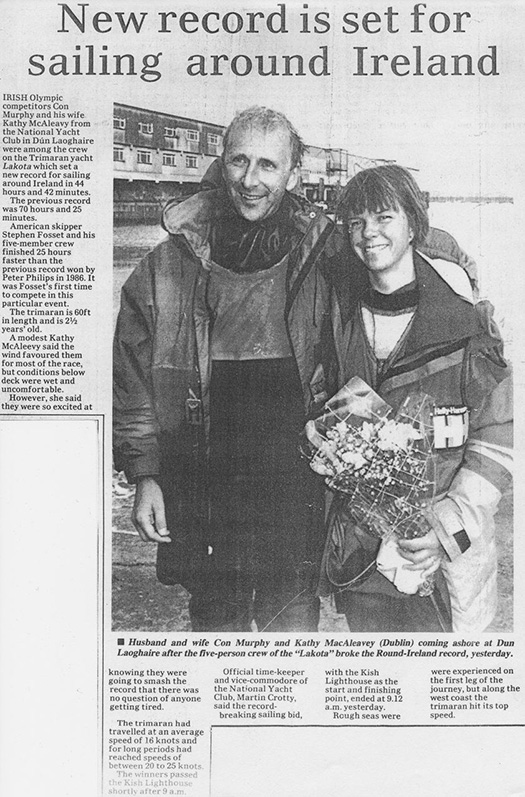
Tired but triumphant – Con and Cathy as pictured in the Evening Herald at the conclusion of Lakota's successful challenge
As it happens, although the monitoring of the challenge has been under Record Commissioner Chris Moore of the National Yacht Club, the crew is distinctly international, with two French – Gavignet himself and veteran Jean Baptiste Leavailliant, plus one Spanish, Alex Pella, and three Omanis who are now Gavignet veterans - Fahad Al Hasni, Yasser Al Rahbi, and Sami Al Shukaili.
The weather pattern was settling in nicely with strong sou'easters when they went off at 1800 hrs on Monday to storm northeastwards from the start point at the Kish L/H through the Irish Sea. But the current spell of volatile weather was making things decidedly moody over the north of Ireland. What had been a useful low pressure area of around 780 had already developed further to have two centres, and it may well have become the case that at least three different vortices were in action to provide unstable wind patterns of rapidly varying strengths, and sometimes no strength at all.
For the first stage, they'd been averaging speeds of up to 25 knots and better, and had confidently been anticipating knocking a cool ten hours off the record. That would have brought it in within the 35 hour working week so beloved of the French. But the fickle North Channel winds had other plans, and they unexpectedly dropped to just 6.32 knots SOG off Cushendall in County Antrim for a frustrating period around midnight on Monday.
Then they got going again along the North Coast, and were well back on track for a new record which, after all, required an average speed of only 16 knots. But one of the low pressure centres off the Donegal coast got itself all over the place through Tuesday afternoon, and progress was at times excruciatingly slow – at one stage northwest of Erris Head in far Mayo, they were crawling along at 3.11 knots, which for a MOD 70 is dead stopped.
The frustration was enormous, for they knew there were strong west to northwest winds on the way, and trying to get to them was the challenge. By Tuesday evening they were at last beginning to benefit, and then Musandam-Oman Sail fairly streaked south in very impressive style, zooming past the Blaskets and shaping her course with an ever-increasing eastern slant past the Skelligs and the Fastnet and along the south coast. She was tacking to lee at speeds which were hauling them rapidly back into the record business, but there was now no way they could make that elusive ten-hours-off-it target.
A least two high profile capsizes with MOD 70s – including on in Dublin Bay a couple of years ago – have shown that while they're able and versatile boats, they have their limits. So in tearing northwards along the east coast this morning in relatively smooth water with the wind off the land, care had to be taken that any sudden squalls off the mountains wouldn't take charge. But everything was kept firmly under control and the job was finished in businesslike style just before 11 o'clock this morning. And they're well pleased with their achievement, as it's a much clearer margin than the 16 minutes with which they bested Bank Populaire's Round Britain and Ireland record last year. So well done, Musandam-Oman Sail. And here's to the good old Lakota – she still sails the sea, a very special boat.
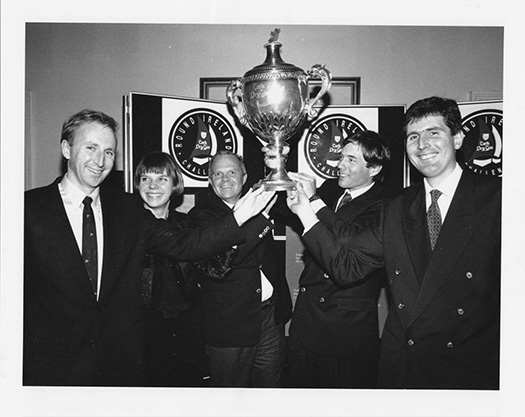
Victory! Lakota's crew with the trophy in 1993 are (left to right) Con Murphy, Cathy MacAleavey, the late Steve Fossett, Steve Scully, and Brian Thompson
#roundireland – Since 1980, the biennial 704-mile Round Ireland Race has been a cornerstone of Ireland's sailing programme. This year's fleet of 36 boats is good for the times that are in it, though it's still a far cry from the heady day of the 1990s when 54 boats came to the line. W M Nixon takes a look at the varied fleet for this 18th Edition of Ireland's Classic.
You wouldn't borrow money to go drinking with Enda O'Coineen on a Saturday night. But if you had to go into the jungle, or face up to a storm at sea, then he's a good man to have around. The intrepid Galwegian has been Irish sailing's gadfly for quite some time now. And more than occasionally, he has driven everyone else nuts - sometimes to the point of total exasperation - with his many cage-rattling schemes.
So his teaming-up for today's start on the Open 60 Teng Tools Kilcullen with Round Ireland Race super-veteran Eamon Crosbie is all of a piece for someone who crossed the Atlantic (at the second attempt) alone in a rubber dinghy, and was himself involved in two successful round Ireland record challenges.
It was the second of these records, in November (yes, November) 1986, which showed just what a cool and tough customer The Enda can be. The lumbering 83ft catamaran Novanet was making good progress on a clockwise circuit in a westerly wind north of Achill when the weather closed in with dark winter violence, a sudden cold front from north of northwest bringing ferocious hail squalls. Where they'd been comfortably clearing the sinister Black Rock off the coast of Mayo, now it was touch and go. Yet in the turbulent sea it was highly unlikely that the cumbersome big machine would be able to tack. The situation was dire, and one of the crew – a known millionaire – offered to buy the boat outright there and then if they'd run her up on a nearby beach.
The rest of them had to shout the options above the screams of the weather. But Enda wasn't saying a word. He just concentrated on taking running fixes of the painfully slowly changing bearing as the Black Rock light showed briefly through the squalls. "We're clearing it," he said quietly. "But by how much?" roared the would-be boat purchaser. "We're clearing it, just keep her going" was all that Enda would reveal.
To this day, nobody knows by precisely how much they did clear the rock on that November evening. It wasn't a lot, and might only have been a few feet. But clear it they did, and within 24 hours Novanet had completed her circuit and the new record stood until September 1993, when Steve Fossett with the 60ft trimaran Lakota established the astonishing record which still stands today.

The lumbering giant.....Enda O Coineen's cool pilotage of the 83ft catamaran Novanet on a stormy November night in 1986 saw her safely past the Black Rock in Mayo, and a new Round Ireland Record next day.
It's unlikely that there'll be any record breaking by the fleet going off this afternoon. For record-breaking purposes, it's best to see Ireland as a sort of green lozenge on a northeast/southwest axis, which means that any serious record-breaking attempt will hope to have a steady period of either nor'westers or sou'easters to give it a head start.
So the forecast of a nor'easter today may indeed send the fleet away in style. But the prospect of a long light airs beat up the west coast as the incoming high pressure builds will make the race a test of patience, and it will be a matter of getting to the finish eventually (and still talking to each other), rather than shaping up for a record.
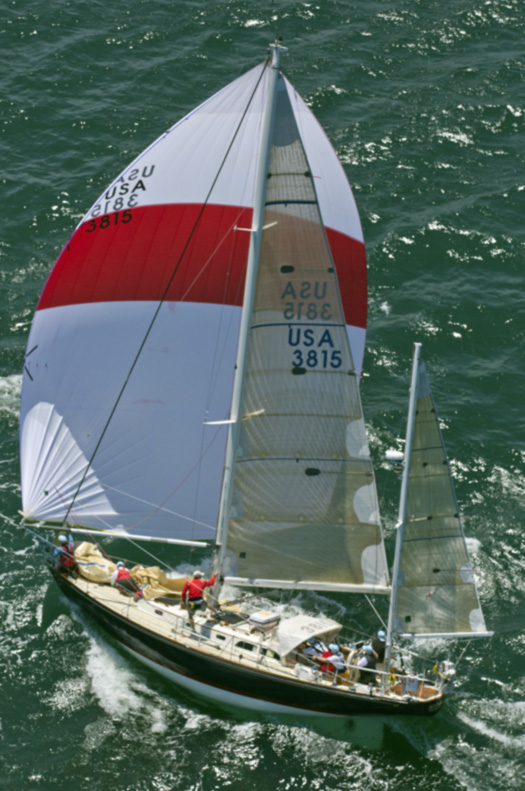
The Hinckley 40 Actaea (Michael Core), a comfortable cruiser-racer which yesterday was declared overall corrected time winner of the biennial 635-mile Bermuda Race. Photo: Daniel Forster
There doesn't seem to be a lot of wind about anywhere in the North Atlantic just now, as America's biennial 635-mile Newport-Bermuda Race has been very slow-sailed this past week since starting on Friday June 20th. For long stages, the best progress was being made by boat which got themselves into the most favourable eddies of the Gulf Stream, which in one location were the equivalent of a fair tide of 2 knots plus. Such conditions favour the lowest-rated most comfortable cruising style boats. So although the mini-maxi Shockwave took line honours, the corrected times were something of a shockwave in themselves, as the overall winner was Michael Core's well-sailed classic Hinckley Bermuda 40 yawl Actaea .
The Round Ireland fleet includes two boats of the same fairly hefty type as Actaea, and even without the news from Bermuda (where the Dark 'n Stormies are being consumed apace), both Ian Hickey's Granada 38 Cavatina from Cork and Brian O'Sullivan & Frances Clifford's Oyster 37 Amazing Grace from Tralee, were already highly favoured in the betting. Cavatina has been in the frame – including overall win – in several Round Irelands, while Amazing Grace celebrated her inauguration in the O'Sullivan/Clifford ownership last year by winning the Dun Laoghaire-Dingle overall after the wind taps had been turned off.
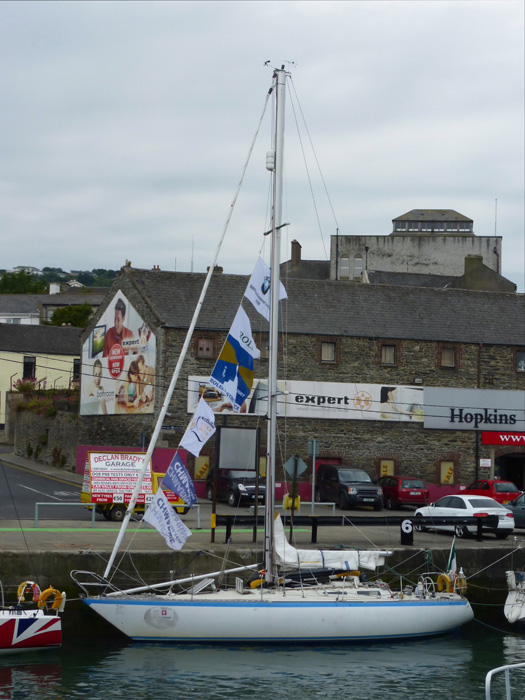
Cavatina in Wicklow on Thursday, with battle flags which reflect her distinguished career. Photo: W M Nixon
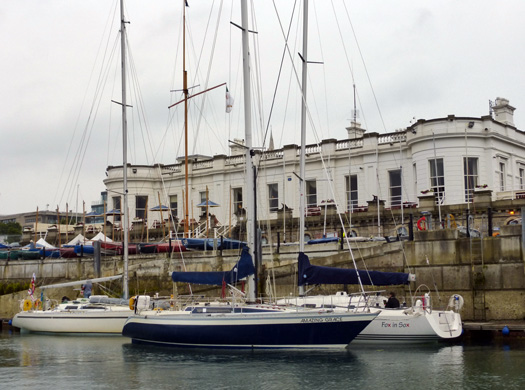
Amazing Grace at the Dun Laoghaire base of the Round Ireland Race at the Royal Irish YC on Thursday. Last year, light winds in the middle stage of the Dun Laoghaire-Dingle Race set up a pattern which provided overall victory for this Tralee Bay boat. Photo: W M Nixon
With Cavatina rated at only 0.922 and Amazing Grace just a little higher at 0.928, they're piling up the advantage just sitting still. But two boats rate even lower. These are the Dehler 34 Big Deal from Foynes, raced by the Listowel father-and-son team of Derek & Conor Dillon in the two-handed division, and the Isle of Man Sigma 33 Manx Polish (Kuba Szymanski) which clocks in at just 0.898, and has impressed with her showing in ISORA racing in recent years.
The smallest boat of all is not the lowest rated. The tiddler of the fleet - just scraping in over the 30ft LOA lower limit - is Ian Patterson's North Channel 9m Wildwood from East Antrim Boat Club in Larne. Having a build date of 2012 makes Wildwood one of the newest boats in what is admittedly a fleet of veteran vessels, but "2012" is a bit notional, as this amateur-build project has taken nine years. But she certainly looks the business, and as a plucky effort, she's in a league of her own.
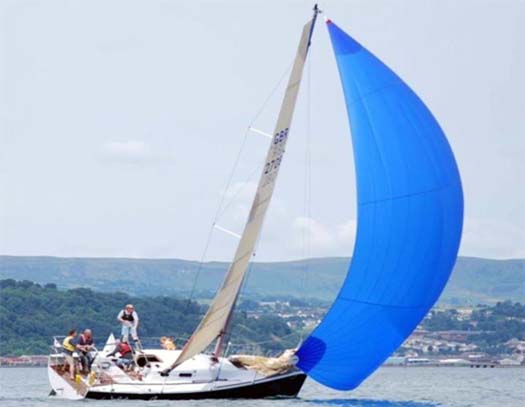
From East Antrim Boat Club at Larne, Wildwood (Ian Patterson) is a remarkable self-build project, and at just 30.5ft LOA, she is the smallest boat in the Round Ireland Race. Photo courtesy WSC
Being very much performance-oriented, Wildwood sails off a rating of 1.02, which puts her well above one of the fancied boats in the two-handed division, Kirsteen Donaldson's Solent-based X 332 Pyxis, rating at just 0.957 and a noted peformer in short-handed racing. Pyxis is just one of many entrants from the RORC heartlands around the English Channel, attracted both by the special challenge of the Round Ireland Race, and by the bonus of the points being weighted 1.4 in the RORC Championship.
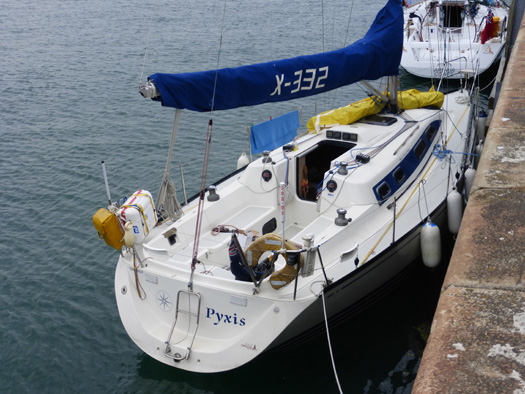
"We're here, and we're going to give it our best shot". Kirsteen Donaldson's X 332 Pyxis is a noted performer in short-handed racing in the English Channel, and was one of the first boats to arrive in Wicklow before the start. Photo: W M Nixon
With the weather forecasts indicating a sou'wester starting to reach the western seaboard by Tuesday evening, the smaller boats which can stick at it will inevitably be favoured. But the best modern offshore racers can be sailing up to their ratings with remarkably little wind, so the likelihood of another excellent overall performance by Laurent Gouy's Ker 39 should never be discounted. And the quality of the boats in the middle of the fleet is notably high, with two J/109s – Liam Shanahan's Ruth from the National, and Peter Dunlop and Viv Cox's Mojito from Pwllheli – having their performance sharpened by shaping up to Frank Doyle's similarly-rated A35 Endgame from Crosshaven.
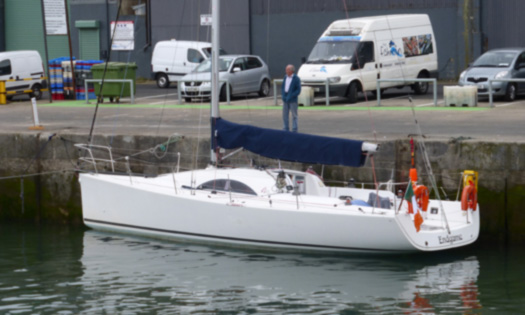
Frank Doyle's slippy A35 Endgame from Cork in Wicklow Harbour, where his father Denis began many successful Round Ireland Races with the powerful Frers 51 Moonduster........ Photo: W M Nixon
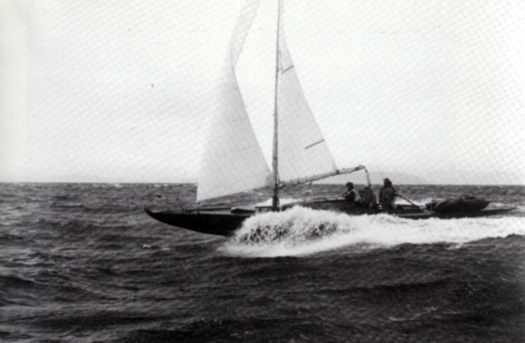
.....but it shouldn't be forgotten that Denis Doyle's offshore racing career began with the hyper-slim 30 Square Metre Vanja IV
The continuation of the name of Doyle of Cork in the Round Ireland annals is a source of special satisfaction to Peter Shearer and his team of organisers in Wicklow, as Frank's father Denis was a stalwart of the race with his Frers 51 Moonduster from 1982 until 2000. And while Moonduster may seem a memory of traditional seagoing strength by comparison with the hyper-light Endgame, never forget that Denis himself started his offshore racing with the 30 Square Metre Vanja IV, which was very austere indeed.
With each new edition, the Round Ireland Race sees increasing involvement by offshore sailing schools offering newcomers to the sport the complete introductory package, with the Round Ireland "medal" in their sailing CV at the end of it. There are several school, club and association challenge boats in the mix this year, a classic example being Irish Offshore Sailing of Dun Laoghaire's campaign with the Jeanneau Sunfast 37 Desert Star. Aboard DS, skipper Ronan O'Siochru finds himself in command of a truly multi-national and multi-cultural crew including professions as diverse as IT specialists, bakers and biochemists, and from several nationalities too – this is modern Ireland goes sailing and then some.
But inevitably, while most of the fleet will be focused on the corrected time win, line honours is where the glamour is to be found. Wicklow farmer David Ryan has leapt into the fray by chartering a Volvo 70 veteran of the 2008-2009 Volvo World Race, the Rob Humphreys-designed Russian boat which now sails the seas as Monster Project.
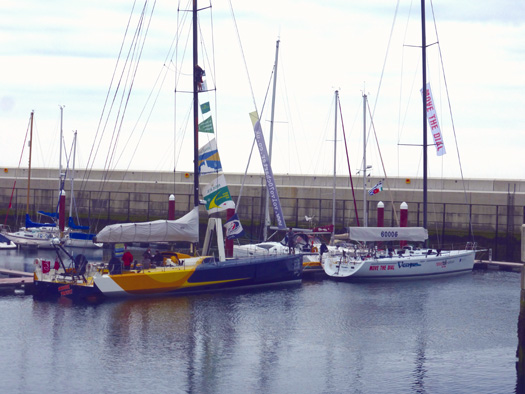
"Greystones has never seen the like of it". Heavy metal in the new County Wicklow marina, with the David Ryan-chartered Volvo 70 Monster Project, and ahead of her Joe McDonald's Farr 60 NewsTalk for Adrenalin. Photo: W M Nixon
The organizational effort involved in running the Round Ireland Race is so great for a small club like Wicklow that in some years WSC don't have an entry to call their own. But Farmer Ryan has blown this out of the water with this mighty boat, which will race with a crew of 18. So totally is this a Wicklowcentric campaign that, although the boat couldn't be berthed in Wicklow Harbour itself, she set up base camp in Greystones where the new marina came to life as another big Round Ireland contender, Joe McDonald's very handsome Farr 60 NewsTalk for Adrenalin, was also in port.
But meanwhile down in Wicklow some determined souls made sure the organising club had some presence beforehand, and both Open 40s – Kevin Rolfe's May Contain Nuts and Austin Clark's Arwen – were there on the outer pier, alongside which there also sat the vintage Volvo Ocean Team Jolokia from Lorient in France, now looking like a bit of maritime history, but a gallant performer nevertheless.

The two Open 40s at Wicklow could not have been more different in their hull style than the veteran Volvo Ocean 60 Jolokia from South Brittany (below). Photos: W M Nixon

All the special boats and everything above 55ft will be aiming at the line honours prize, and in the Teng Tools Kilcullen challenge we see a formidable project. The linkup between Enda O Coineen and Eamon Crosbie goes right back to the late great Jim Poole. Eamon was Jim's crew in the two-handed three-stage Round Ireland Race from Ballyholme in 1975, and Enda was in the strength on Jim's Half Tonner Feanor when she won IOR overall in the first Wicklow Round Ireland in 1980.
Since then, Eamon has become part of the round Ireland racing story with his successes with the Ker 32 Voodoo Chile, while Enda's seaborn interests are diverse and absorbing. But for both of them, this linkup in the chartered Open 60 Artemis represents enough new ground for fresh excitement, while continuing to utilize their unrivalled experience.
They've decided to race with a total crew of seven, including metman/routing expert/Open 60 veteran Wouter Verbak. The other four in addition to the joint skippers are Mark McGibney, Andy Greenwood, Greg Parker and Alan Crosbie, the latter fresh from sailing on Quest, the overall winner of the ICRA Nats.
It's undoubtedly a crew of all the talents, and if the weather performs as expected, at 1400 hrs today we can expect to see the likes of Monster Project and Teng Tools Kilcullen streaming away from Wicklow in formidable style while the smaller boats bob in their wakes. But as many who have raced round Ireland or indeed just cruised round will know, the Atlantic seaboard can seem to be one very long bit of coastline when the wind is light from ahead. For little boats, knowing there are sou'westers advancing slowly from the ocean, it may well be a case of everything coming – and coming right – for those who wait.
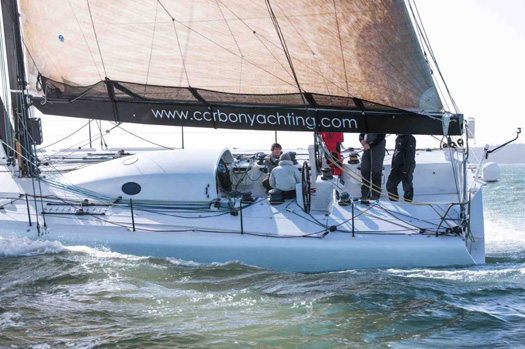
Teng Tools KIlcullen is being sailed by one of the most talented crews in the Round Ireland Race 2014.
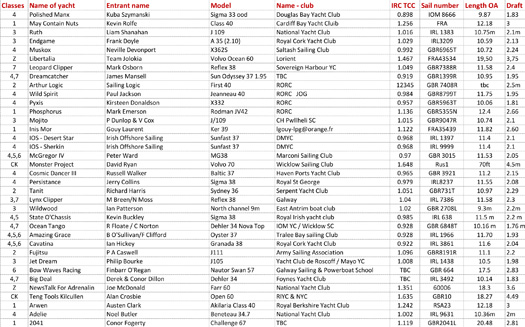
Round Ireland Entry list 2014





























































